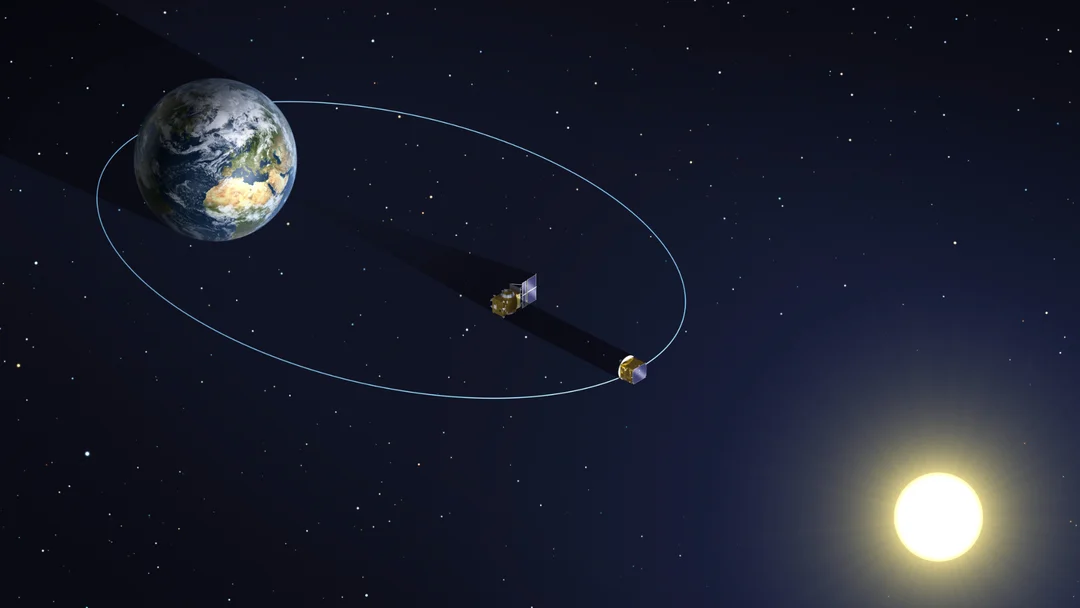
ESA’s Proba-3 Achieves Unprecedented Precision in Formation Flying, Revolutionizing Space Exploration
In a groundbreaking achievement, the European Space Agency (ESA) has successfully demonstrated ultra-precise formation flying with its Proba-3 mission. This milestone marks a significant leap forward in space technology, opening doors for advanced scientific research and future space endeavors. The mission, consisting of two spacecraft, the Occulter and the Coronagraph, has proven the ability to maintain perfect formation at a distance of 150 meters with millimeter precision.
This level of accuracy was achieved through a network of sensors, including the Fine Lateral and Longitudinal Sensor (FLLS) laser instrument, a shadow position sensor, and camera-based systems, all working in conjunction with onboard software and cold gas thrusters. Damien Galano, Proba-3 project manager, emphasized the achievement, stating, "We are talking about millimetric accuracy in range, and sub-millimetric in the lateral position."

The primary goal of the Proba-3 mission is to study the Sun's corona by creating artificial solar eclipses. The Occulter blocks the sun's direct light, allowing the Coronagraph to observe the faint outer atmosphere, a feat usually only possible during total solar eclipses on Earth. These artificial eclipses will provide scientists with valuable data to unravel mysteries surrounding the sun's corona, solar wind acceleration, and coronal mass ejections.
However, the implications of this precision formation flying extend far beyond solar research. The technology could revolutionize Earth observation by enhancing the resolution and data quality of satellite imagery. It also lays the foundation for complex operations like docking spacecraft, searching for exoplanets with dedicated occulters and observatories, and even detecting gravitational waves from space.

The two Proba-3 spacecraft, launched by an Indian PSLV rocket, operate in a highly elliptical orbit. The formation flying is most efficiently maintained as they move toward their farthest point from Earth, where gravitational effects are minimized. Despite this, the spacecraft flawlessly managed their relative positions autonomously utilizing onboard systems, showing a high degree of technological advancement.
Teodor Bozhanov, formation flying system engineer, described the process where ground control initiates the formation-flying sequence, and then the spacecraft takes over using the Visual Based System, analyzing the relative position with a wide angle camera to track flashing LEDs on the Corongraph.
"All the rest is done autonomously. The spacecraft measure and control their relative position using the Visual Based System, which includes a wide-angle camera on the Occulter tracking a set of flashing LED lights on the Coronagraph. Once the satellites get close enough to each other, a narrow-angle camera locking onto the same set of lights enables a more accurate positioning."
Prior to achieving this incredible precision, engineers struggled to close the millimeter gap. As Raphael Rougeot, Proba-3 System Engineer noted, that the team needed to calibrate the on-board laser instrument, as well as using the shadow position sensor in order to close the precision gap.
With the successful completion of this landmark formation-flying test, the Proba-3 mission is now poised to carry out its scientific objectives, promising groundbreaking insights into our Sun and paving the way for a new era of collaborative space exploration. The ESA hopes to produce the first processed image of the sun's corona in the near future.
What are your thoughts on the potential impact of Proba-3's precision formation flying on future space missions? Share your opinions and ideas in the comments below!